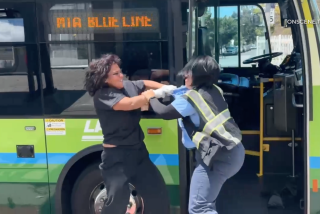Greyhound Talks Stalled; Silence Notes Striker’s Death
- Share via
Strained silence was the order of the day in the Greyhound bus strike Wednesday.
Picketing drivers around the nation observed five minutes of silence in memory of a striker killed on a picket line in Redding; and silence continued between the drivers’ union and Greyhound’s management, with no new negotiations scheduled.
P. Anthony Lannie, Greyhound’s executive vice president and chief negotiator, said, “it would not be fruitful” to resume talks with the Amalgamated Council of Greyhound Local Unions. Talks broke off when the strike began last Friday. Lannie said the union, which asked earlier this week to return to the bargaining table, has failed to grasp that “the company has offered every single red cent that it can afford to pay.”
In Washington, Sen. Howard Metzenbaum (D-Ohio), chairman of the Senate’s subcommittee on labor, urged Labor Secretary Elizabeth Dole to personally intervene in the strike “to bring the parties together.” In a letter also signed by Sen. Alan Cranston (D-Calif.) and nine other senators of both political parties, Metzenbaum expressed “grave concern” about the safety consequences of Greyhound’s use of replacement drivers.
In Redding, where striker Robert Waterhouse was killed Saturday by a bus driven by a replacement, nearly 500 mourners--half of them striking drivers wearing their Greyhound uniforms with black armbands--marched two miles to a memorial service.
Some wept while others swore quietly as they walked past a damaged wall of the Greyhound bus terminal. A chunk of plaster was torn out of the wall by the bus that pinned Waterhouse, 59, to the building.
Ed Strait, president of the council of Greyhound locals, told mourners that any union member who crosses the picket line “is walking across the grave of Bob Waterhouse.”
The 160,000-member Amalgamated Transit Union, with whom the Greyhound locals are affiliated, asked members to observe five minutes of silence Wednesday to coincide with the 1 p.m. memorial. At Greyhound’s downtown Los Angeles service yard, 11 pickets, some bowing their heads, silently stood in front of the driveway, watched by two security guards.
Shasta County authorities have yet to decide whether to prosecute Theodore Graham, 42, of Portland.
Graham had received five tickets in five years, Oregon motor vehicle records show. But a Greyhound spokesman said that would not have barred him from employment because the bus line permits drivers to have three moving violations in three years.
The Greyhound union, which represents the company’s 6,300 drivers and 3,075 office and maintenance workers, struck after Greyhound refused to increase its pay offer for a new contract.
In the absence of negotiations, allegations flew between labor and management.
Union leaders in Los Angeles said Greyhound’s Los Angeles safety director, Rudy Krause, had submitted his resignation because of disagreements over standards used to train replacement drivers. Krause and Greyhound executives in Dallas refused to comment.
Greyhound confirmed union claims that several dozen replacement drivers had quit within days of being hired. The company said the total was about 8% of the 700 replacements hired so far.
Greyhound said its most recent figures indicated that on Tuesday, it ran 31.7% of its normal schedule nationwide. Union officials insist that observations by strikers indicate no more than 15% of the buses are running.
The union contended that Greyhound is violating interstate transportation regulations by overbooking buses and forcing some passengers to stand. However, the federal Department of Transportation said up to 12 persons are allowed to stand on buses.
The company says it will add 300 more to its roster of 700 replacement drivers by the end of the week. Officials claim about 350 more union drivers have crossed the picket line. Union leaders place the number at fewer than 100.
The union has sought a higher pay raise than the 6.9% Greyhound says it is offering in the first year of a three-year contract. Drivers say they are owed more because they agreed to sharp pay cuts in the 1983 and 1987 contracts, and because Greyhound recorded a small profit last year after losing $20 million in the previous two years.
Also at issue is Greyhound’s proposal to contract some work to private bus companies.
More to Read
Sign up for Essential California
The most important California stories and recommendations in your inbox every morning.
You may occasionally receive promotional content from the Los Angeles Times.













